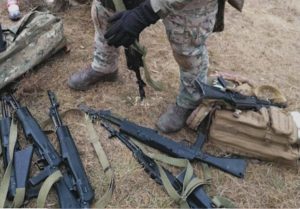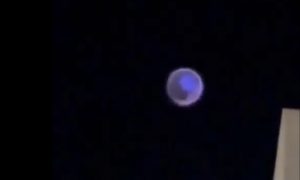At the beginning of the Russian full-scale invasion, the Ukrainian-made Stugna-P and Corsair anti-tank guided missile systems were in service with the Armed Forces of Ukraine.
These systems along with ATGMs, which were supplied to Ukraine within the framework of international military assistance (primarily the U.S.-made Javelins), destroyed many various Russian armored vehicles.
From open sources, it is known that the Ukrainian Army, before the great war with the Russian invaders, received thousands of guided missiles and hundreds of launchers produced in Ukraine.
What is Stugna-P
Stugna-P is a Ukrainian second-generation heavy anti-tank missile system, developed and produced by the Kyiv Luch Design Bureau. Its creation continued in 2005-2010. In April 2011, the Stugna-P ATGM was adopted by the Ministry of Defense of Ukraine. Its export version was called “Skif.” The system was actively exported to various countries.

The system has a laser beam-riding anti-tank missile guidance system that launches in semi-automatic mode. ATGM can fire R-2 missiles in various modifications of 130 or 152 mm caliber located in the guided missile launch assembly. Missiles are equipped with different warheads: tandem-charge HEAT or HE-Frag. The missiles in the system can strike tanks and other equipment or fortifications. The anti-tank system hits targets at a maximum distance of 5 km and penetrates 800 or 1100 mm of armor, depending on the missile used.

Stugna-P is equipped with a laser beam guidance system. Control of the systems is carried out remotely from a defilade position (specially prepared shelter) with the help of a remote control that is placed at a distance of up to 50 m. The basic version consists of a tripod, a container with a missile, a guidance device, and a remote control panel, which allows the operator to conduct a launch from a safe distance. The maximum range in the daytime is 5000 m, at night – 3,000 m.

The Armed Forces of Ukraine started ordering Stugna-P ATGM en masse with the beginning of the war in Eastern Ukraine. The system, in particular, was used in the defense of Donetsk Airport in 2014-2015 to destroy Russian armored vehicles.
Corsar ATGM

The Ukrainian Corsar ATGM from Luch Design Bureau is designed to defeat stationary and moving targets with composite, spaced, or monolithic armor, including reactive armor. The missiles of the system allow it to strike tanks, armored personnel carriers, as well as helicopters that hover above the ground or fly at low altitudes. The system is also capable of striking small targets, such as long-term firing points. The Corsar was adopted by the Ukrainian army in August 2017 and also exported to other countries.

In 2018, it was assembled as a Jadara Terminator in Jordan by the local Jadara Equipment.

Missile guidance is carried out by a laser beam. The anti-tank system is equipped with missiles in a guided missile launch assembly with tandem-charge HEAT (RK-3K) and high-explosive (RK-3OF) warheads. The maximum fire range is 2500 meters. The system provides firing from the tripod or from a stop in prepared and unprepared positions both during the day and at night with the use of a thermal imaging camera.

Corsar ATGM specifications:
- Maximum range: 2500 m;
- Laser beam semi-automatic guidance system;
- Tandem-shaped-charge warhead with armor penetration with reactive armor, not less than 550 mm;
- High explosive with explosively formed penetrator warhead with armor penetration of at least 50 mm;
- Launcher weight: 12 kg;
- Tripod weight: 8.3 kg;
- Weight of the rocket in the container: 15.5 kg;
- Missile caliber: 107 mm;
- Temperatures range from -40℃ to + 60℃.
Destruction of Russian military equipment
After the start of the Russian full-scale invasion in February 2022, the State Kyiv Design Bureau Luch transferred to the Ukrainian military anti-tank missiles and launchers, which were intended for export to other countries.

Specialists of the Bureau also trained new anti-tank crews of the Armed Forces of Ukraine to use these weapons.
With the help of Stugna-P and its export version, Skif, the Ukrainian military has many times managed to destroy and hit Russian tanks. In particular, such vehicles as Т-90М Proryv, infantry fighting vehicles (BMP), MT-LB, BRDM-2, armored personnel carriers, and other equipment. These cases were very often caught on video.
For example, the case of Lviv paratroopers, who destroyed the TZM-T Support Reloading Vehicle of the Russian TOS-1 heavy flamethrower system with the help of the domestic ATGM.
There were also cases of shooting down Russian helicopters in the air — in particular, those were Ка-52 attack helicopters — with guided missiles from the Stugna-P ATGM. They were destroyed by the soldiers of the 95th Air Assault Brigade of the Armed Forces of Ukraine.
Another interesting case occurred in the spring, when the Ukrainian operator of the Stugna-P ATGM destroyed the Russian Sturm-S self-propelled anti-tank system in Zaporizhzhia. This happened in early April 2023.
The Russian invaders tried to film a rather rare anti-tank self-propelled gun, but instead recorded the moment when a Ukrainian anti-tank guided missile hit the Sturm-S, which led to its destruction along with a crew of two people.
The Corsar ATGM started entering the service of the Ukrainian army a few years before the great war with Russia.

The Luch Design Bureau is constantly working to improve its anti-tank missile systems. In May 2020, engineers added the Corsar thermal imaging sight. Such ATGMs were mastered by those Ukranian crews that received appropriate training: Command of the Ground Forces, Air Assault Forces, Special Operations Forces, and the Marines.
Training of the first group of instructors—operators of the Stugna-P and Corsar anti-tank missile systems of the Territorial Defense Forces of the Armed Forces of Ukraine, was finished just two weeks before the full-scale invasion in the Kyiv region.

Those instructors shared their theoretical knowledge and practical skills in the use of domestic ATGMs with the personnel of TDF battalions. In particular, the fighters of one of the Territorial Defense brigades of the city of Kyiv were involved in the courses. The training course lasted about 10 days. It included both a theoretical component and practical actions, during which military personnel improved their skills.

The Corsar ATGM operators also receive simulators from Ukrainian benefactors. In September 2023, the Come Back Alive Foundation transferred five Corsar ATGM simulators to provide the largest training centers of the Ground Forces of the Armed Forces of Ukraine, in which the training of the military is carried out.

From the very beginning of a great war with Russia, Ukrainian Territorial Defense units, soldiers of the National Guard, and the Armed Forces destroyed a variety of enemy military equipment on various front lines: tanks, IFVs, and others, with the help of the Corsar ATGM.
In particular, in June 2022, the Ukrainian military stopped the advance of Russian armored vehicles in the Donetsk region with the help of Ukrainian anti-tank systems.
In the area of the village of Bohorodychne, the military of Ukraine successfully destroyed the Russian Т-80 tank.
Ukrainian Corsar anti-tank systems are also in service with the National Guard, whose soldiers are actively using this ATGM on the front lines, striking Russian military equipment.
Ukrainian ATGM today
In February 2023, the National Guard of Ukraine received UAH 130 million for ordering domestic Stugna-P anti-tank missile systems. These funds had to be noted in the contracts.
In August 2023, it became known that Ukraine had quadrupled the production of domestic Stugna-P ATGMs since the beginning of this year. This was stated by Oleksandr Kamyshin, Minister of Strategic Industries of Ukraine.
“We produced 4 times more Stugna in July than in January. And we are moving in increasing production further. No matter how much we produce it now. It won’t be enough,” he said.

According to a representative of the Luch Design Bureau, the Defense Forces of Ukraine are using a new version of the Skif-M anti-tank missile system, which is also known in the Armed Forces as Stugna-P. This version of the ATGM was developed by the design bureau in 2022, due to the experience gained in the war against Russia. The updated complex received some improvements to the launcher: the weight of the tripod was significantly facilitated, and the installation received new turning and lifting devices and better power batteries.

This version of Stugna-P received a new lightweight remote control panel and a new LV-U aiming and guidance module, which, at the request of the Ukrainian military, integrated a laser rangefinder to better determine the distance to the target to be hit.

For the first time, a new version of the Ukrainian anti-tank system was presented in February 2023 at the IDEX-2023 exhibition in the United Arab Emirates.
Returning to the Corsar ATGM, we can recall that the Turkish manufacturer Best Grup recently integrated a guidance device and an RK-3 missile made by the Ukrainian Luch Design Bureau on the Koralp remote weapon station. The module, in addition to missiles, can be equipped with 12.7x99mm or 12.7x108mm machine guns.

The RK-3К and RK-3OF missiles of the Corsar anti-tank missile system provide damage to heavily armored equipment and other targets at a range of up to 2.5 kilometers.
Negotiations on cooperation between Ukrainian and Turkish companies began in 2021 at the IDEF-2021 exhibition in Istanbul. The work of the Ukrainian Luch was not stopped by a full-scale war with Russia.
Results
Ukrainian anti-tank systems contributed to the destruction of a large amount of enemy equipment and the reduction of the military potential of the Russian army. With the help of the Stugna-P and Corsar ATGM, Ukrainian soldiers stopped the advance of the invasion troops and destroyed helicopters and manpower.
The further development of domestic anti-tank missile systems makes Ukraine independent in providing its troops with precision missiles that can accurately hit a tank, IFV, or APC of the enemy or a specific window in the house where the Russian sniper is located.

However, the Stugna-P and Corsar ATGM need further modernization. The main drawback of the Stugna system is its weight, which requires the involvement of several military personnel to carry elements of this ATGM.

With the appearance of more modern tanks on the battlefield, it is also necessary to increase the capabilities of armor penetration on the warhead.
SUPPORT MILITARNYI
Even a single donation or a $1 subscription will help us contnue working and developing. Fund independent military media and have access to credible information.


 Urich
Urich 
 Андрій Харук
Андрій Харук 
 Контужений Безпілотник
Контужений Безпілотник 

 Центр ініціатив ПЖ
Центр ініціатив ПЖ 



 Vadim Kushnikov
Vadim Kushnikov 
 Андрій Тарасенко
Андрій Тарасенко 
 Юрій Юзич
Юрій Юзич 
 Віктор Шолудько
Віктор Шолудько 
 Роман Приходько
Роман Приходько 



